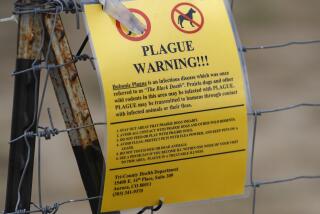Where to Get Information About Bioterrorism
- Share via
Smallpox is wildly contagious, there’s no treatment, and the disease kills about 30% of those it infects. Anthrax is not contagious but kills up to 90% of those who contract it, within days of the appearance of symptoms. In the last two weeks, Americans have learned more about biological terrorism than they ever wanted to know. So far, experts have played down the immediate danger. The death of a man in Florida from inhaled anthrax and the exposure of at least two of his co-workers were isolated cases, even if highly suspicious, investigators say. But the will and the means to inflict such terror are certainly out there. No expert pretends to know exactly how advanced anti-American terrorists’ biological weapons are. Several groups have been following the threat for years:
Johns Hopkins University Center for Civilian Biodefense Studies
https://www.hopkins-biodefense.org
Johns Hopkins’ project on bioterrorism has benefited from the guidance of Dr. Donald A. Henderson, who oversaw the global campaign to eradicate smallpox a generation ago and who recently was appointed to head the White House’s new bio-terrorism panel. The site gives quick, authoritative summaries of the agents terrorists are thought most likely to use--anthrax, botulinum toxin, smallpox, plague and tularemia, a highly infectious bacteria that can cause lung failure. But the best feature is a consumer fact sheet titled “FAQ: Information for the General Public,” which answers crucial questions such as: “Should I buy a gas mask?” And “Is it safe for me to drink water from the tap?” The answers are: no (“a mask would only protect you if you were wearing it at exactly the moment an attack occurred,” the site says, which effectively means all the time) and yes (any agent dropped into the water supply would be enormously diluted and treated with chlorine). The site also has congressional testimony and even book reviews.
Centers for Disease Control and Prevention
https://www.cdc.gov/ncidod/diseases/bioterr.htm
The CDC’s site is geared mainly to other doctors and public health types, but there’s good readable information for the rest of us too. It has good background on specific agents, from anthrax to botulism to the plague. You will learn that one of the distinct symptoms of pneumonic plague is a watery or bloody sputum; that, for smallpox, the incubation period between exposure and symptoms is seven to 17 days; and that botulism is a toxin that attacks the nerves and quickly causes blurred vision and muscle weakness that spreads through the body. The site also has a link to a 1999 issue of the Journal of the American Medical Assn. that discusses how the public health system would handle outbreaks of several deadly agents. What the site does not do well is draw a picture of how each of these agents would move through the population.
Maryland Department of Public Health
https://www.dhmh.state.md.us/eis6501/biotbiot.htm
Maryland’s public health department posts a massive collection of articles on bioterrorism from government agencies, including the Army, as well as academic sources. Here you’ll find a readable review discussion of the smallpox outbreak in Europe in the 1970s and the accidental release of anthrax in Russia in 1979.
Another essay tries to anticipate what an attack might look like from a public health point of view. “A bioterrorist attack may be difficult to distinguish from a naturally occurring infectious disease outbreak,” and could be set off by any microorganism, it says. In the 1990s, a cult in Oregon infected 751 people by dosing salad bars with salmonella, for example.
The site also offers a detailed simulation analysis in which scientists calculate how many people would get sick, and how fast, if terrorists sprayed anthrax over a typical suburb of 100,000 people. It’s grim; but at least someone has thought about it.
Finally, the Los Angeles County Department of Health’s site, https://www.labt.org, gives contact numbers for anyone who wants to report problems, as well as fact sheets on deadly agents.






